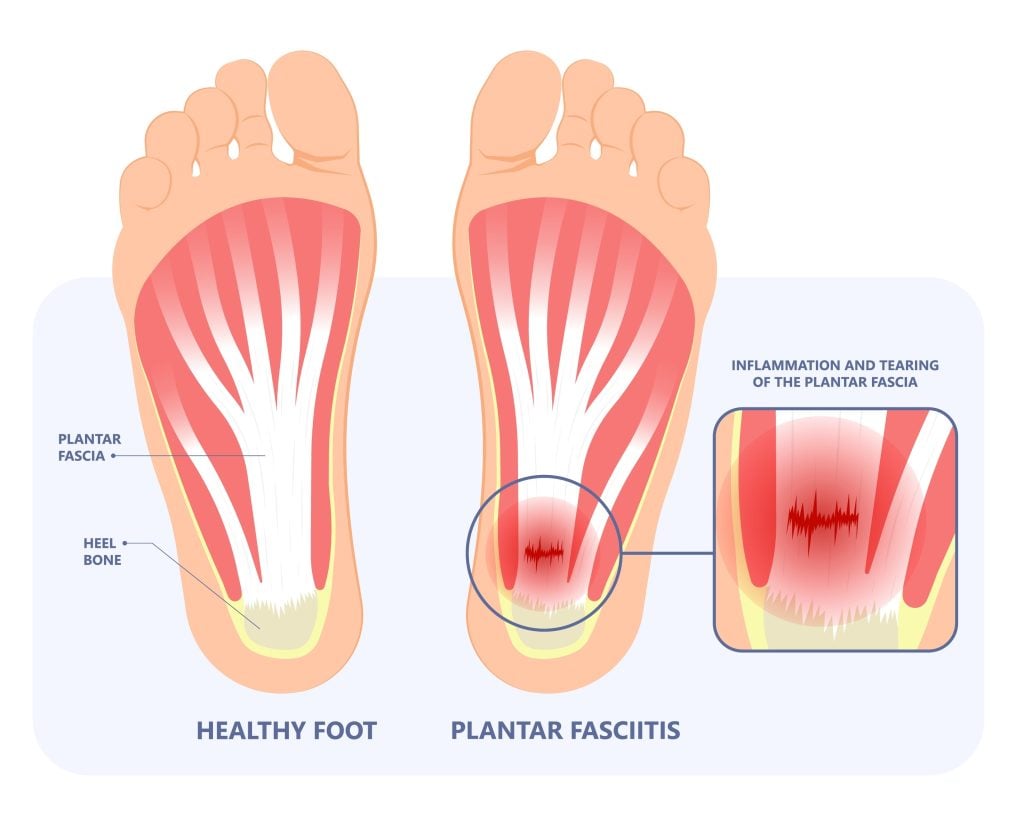Research suggests that plantar fasciitis affects up to 10% of adults during their lifetime, making it one of the most common causes of heel pain.
When you’re experiencing that characteristic sharp pain in your heel, particularly during your first steps in the morning, you’re likely dealing with inflammation of the plantar fascia—the thick band of tissue connecting your heel to your toes.
While this condition can be debilitating, understanding the precise stretching techniques recommended by podiatrists will equip you with essential tools for managing and potentially resolving your heel pain through targeted therapeutic approaches.
Key Takeaways
- Podiatrists recommend calf stretches to loosen tight calf muscles that contribute to heel pain and plantar fasciitis.
- Towel curls, toe stretches, and rolling stretches are essential exercises to promote flexibility and relieve heel pain.
- Stretching exercises targeting plantar fascia, calf muscles, and tissues are crucial for alleviating heel pain and promoting healing.
- A consistent stretching routine reduces tension and enhances foot health, aiding plantar fasciitis recovery and long-term management.
- Incorporating stretches that promote blood flow and strengthen foot muscles can help alleviate plantar fasciitis symptoms and prevent future complications.
Understanding Plantar Fasciitis and Heel Pain
Plantar fasciitis, one of the leading causes of heel pain, arises from inflammation of the tissue band known as the plantar fascia that supports your foot’s arch. This condition often manifests as sharp heel pain, particularly noticeable in the morning or after periods of inactivity. According to the Mayo Clinic, factors such as overuse, abnormalities in foot structure, and inadequate footwear can aggravate this inflammatory response.

Incorporating a structured regimen of stretches and exercises is essential to combat the discomfort of plantar fasciitis and promote healing. Regular stretching of the plantar fascia and associated muscles around the foot and calves can alleviate tension and tenderness.
Experts recommend specific exercises to target the affected areas, such as toe stretches, rolling stretches, calf stretches, and towel curls. These stretches not only reduce pain but also help improve flexibility, which is key to preventing future injuries.
Benefits of Stretching for Plantar Fasciitis
Stretching is pivotal in managing plantar fasciitis by directly targeting the structures responsible for heel pain. When you engage in stretching exercises, you relieve tension in the plantar fascia and enhance flexibility in the foot and surrounding muscles. The Mayo Clinic highlights the importance of these exercises, recommending them as a critical component in alleviating discomfort and preventing future flare-ups.
Integrating a routine of plantar fascia stretches can bring several benefits:
-
Enhanced Muscle Strength
Strengthening foot muscles reduces stress on the plantar fascia ligament, aiding quicker recovery.
-
Improved Flexibility
Regular stretching fosters greater flexibility in the lower leg and foot, reducing pain.
-
Injury Prevention
Conditioning the plantar fascia and related structures lowers the risk of further injury or strain.
-
Morning Relief
Stretching before getting out of bed boosts blood flow and reduces morning stiffness.
We podiatrists recommend these stretches due to their potential to enhance overall foot health. Incorporating forms like calf stretches, toe stretches, and towel curls into your daily routine will address plantar fasciitis symptoms and promote ideal foot function. You’re on the path to freedom from heel pain!
Essential Stretches for Pain Relief
As you begin incorporating stretches into your daily routine, focus on essential exercises that target the tight calf muscles, strengthen foot muscles, and promote blood flow to the affected area:
Calf Stretches
Calf stretches are vital in loosening tight calf muscles, which can contribute to heel pain. Stand facing a wall with one hand on the wall for balance and one foot back about a foot, keeping your heel on the ground. Bend your front knee and lean forward, stretching your back leg.
Below is a useful video tutorial from Sharp Healthcare on how to effectively perform two variations of the calf stretch to help relieve your plantar fasciitis pain:
Toe Curls & Stretches
Towel curls and plantar fascia stretches also promote flexibility and strengthen foot muscles. Regularly performing these exercises can help reduce the pain and discomfort associated with plantar fasciitis.
To help you better understand these valuable exercises, we have two great video tutorials from Physiotutors and the NHS UK below that we encourage you to watch closely:
Foot Rolls
Roll a round object like a tennis ball or frozen water bottle under your foot for more profound tissue relief. This rolling motion helps break up adhesions in your foot muscles while reducing inflammation.
Here is a useful video tutorial from Dr. Beau Beard on how to effectively perform foot rolling for plantar fasciitis relief:
Incorporating these podiatrist-recommended stretches into your daily routine can contribute to better foot health and faster recovery from heel pain. By targeting specific areas, you can work toward alleviating heel pain and achieving freedom from the limitations of plantar fasciitis.
When to Consult a Heel Pain Podiatrist
Despite the benefits of at-home stretches and exercises, specific symptoms warrant immediate professional evaluation by a heel pain specialist. When you’ve consistently performed recommended plantar fascia stretches but haven’t experienced significant relief, it’s time to seek expert consultation.
You should also schedule an appointment if your heel pain interferes with daily activities or persists for several weeks despite conservative treatments.

A qualified podiatrist will conduct a thorough assessment to identify the underlying causes of your heel pain. While plantar fasciitis is a common diagnosis, other conditions may require different treatment approaches. Your podiatrist will evaluate your foot mechanics, gait patterns, and medical history to develop an individualised treatment plan that addresses your needs.
Professional intervention can expedite your recovery and prevent long-term complications. Your podiatrist may recommend modified exercises, custom orthotics, or additional therapeutic modalities beyond basic stretches. We’ll also monitor your progress and adjust your treatment plan accordingly, ensuring you receive the most effective care for your case.
In Closing...
Incorporating these podiatrist-recommended stretches into your daily routine can significantly alleviate heel pain associated with plantar fasciitis. By strengthening your foot’s natural arch support and promoting the healing of inflamed tissue, you can prevent chronic complications and maintain optimal foot health.
If your symptoms persist or worsen, don’t hesitate to consult Bellevue Podiatry. Bellevue Podiatry’s experienced podiatrists dedicate themselves to personalised care and tailored treatment plans, ensuring your feet remain a reliable foundation for peak mobility. Schedule an appointment today to take the first step towards stepping pain-free again.
If you want the right professional advice on how to treat your heel pain, we currently have a limited offer running to help you out. For just $79 (usually valued at $189), book in online for our Complete Heel Pain Assessment & Treatment Consultation will get:
- Complete In-Depth Heel Pain Examination
- Review of Footwear & Personal Habit Diagnosis
- Treadmill Walking Gait Analysis & Video Assessment
- Complete Foot & Ankle Structural Diagnosis
- Effective Heel Pain Treatment Plan To Get You Walking Pain Free
- Peace of Mind You Know What Is Causing Your Heel Pain & How To Fix It
Heel Pain & Plantar Fasciitis
Understand what causes your heel pain and what you can do to get rid of it once and for all. Find out what treatments can get you back to walking pain free so you can enjoy living an active life again!


Bellevue Podiatry
Bellevue Podiatry has been serving the people of Rosanna and its surrounding suburbs for over 10 years. We have the qualifications, experience and education to effectively treat any lower limb condition or injury that requires expert podiatry care.
Article references:
If you would like a deeper understanding of the treatment podiatrists use for plantar fasciitis, please click on the links below:
- OrthoInfo: https://orthoinfo.org/en/diseases–conditions/plantar-fasciitis-and-bone-spurs/
- Mayo Clinic: https://www.mayoclinic.org/symptoms/heel-pain/basics/causes/sym-20050788
- American Podiatric Medical Association: https://www.apma.org/patients-and-the-public/conditions-affecting-the-foot-and-ankle/heel-pain/
- MedlinePlus: https://medlineplus.gov/ency/article/007021.htm
- Medical News Today: https://www.medicalnewstoday.com/articles/324353
